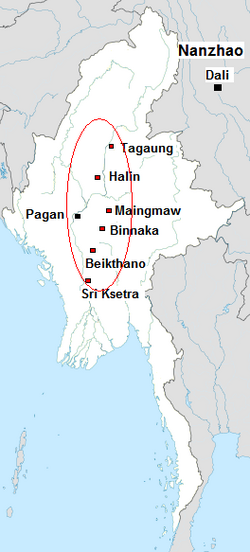อาณาจักรศรีเกษตร
อาณาจักรศรีเกษตร (พม่า: သရေခေတ္တရာ ပြည်, เสียงอ่านภาษาพม่า: [θəjè kʰɪʔtəjà pjì]; สันสกฤต: श्री क्षेत्र, แปลว่า 'ทุ่งเกษตรแห่งความรุ่งเรือง'[1] หรือ 'ทุ่งเกษตรแห่งความรุ่งโรจน์'[2]) เป็นนครรัฐของชาวปยู ตั้งอยู่บริเวณลุ่มแม่น้ำอิรวดีในภาคกลางและภาคใต้ของประเทศพม่าในปัจจุบัน ครั้งหนึ่งเคยเป็นชุมชนปยูที่โดดเด่น ชาวปยูครอบครองพื้นที่หลายแห่งทั่วพม่าตอนบน โดยศรีเกษตรได้รับการบันทึกว่าเป็นเมืองที่ใหญ่ที่สุด มีกำแพงเมืองครอบคลุมพื้นที่ 1,477 เฮกตาร์[3] อย่างไรก็ตามการสำรวจเมื่อเร็ว ๆ นี้พบว่าภายในกำแพงเมืองอิฐขนาดใหญ่ครอบคลุมพื้นที่ 1,857 เฮกตาร์ เมื่อเทียบกับดินแดนภายนอกที่ขนาดใกล้เคียงกัน ถือเป็นเมืองที่ใหญ่ที่สุดในเอเชียตะวันออกเฉียงใต้ก่อนสมัยเมืองพระนคร ประเด็นเกี่ยวกับการกำหนดอายุของพื้นที่นี้ ส่วนใหญ่มักคาดกันว่ามีอายุระหว่างคริสต์ศตวรรษที่ 7 ถึง 9 อย่างไรก็ตามงานวิจัยล่าสุดชี้ให้เห็นว่าวัฒนธรรมปยูที่ศรีเกษตร มีการดำรงอยู่มาหลายศตวรรษก่อนหน้านี้
อาณาจักรศรีเกษตร သရေခေတ္တရာ ပြည် | |||||||
|---|---|---|---|---|---|---|---|
| ราวคริสต์ศตวรรษที่ 3 ถึงคริสต์ศตวรรษที่ 9–ราว ค.ศ. 1050 | |||||||
 | |||||||
| สถานะ | นครรัฐ | ||||||
| เมืองหลวง | ศรีเกษตร | ||||||
| ภาษาทั่วไป | ภาษาปยู | ||||||
| ศาสนา | ศาสนาพุทธ, วิญญาณนิยม, ศาสนาพราหมณ์ | ||||||
| การปกครอง | ราชาธิปไตย | ||||||
| ยุคประวัติศาสตร์ | สมัยคลาสสิก | ||||||
• สถาปนา | ราวคริสต์ศตวรรษที่ 3 ถึงคริสต์ศตวรรษที่ 9 | ||||||
• ประกาศใช้ปฏิทินพม่า | 21 มีนาคม ค.ศ. 640 | ||||||
• พระเจ้าดุตะบอง | 25 มีนาคม ค.ศ. 739 | ||||||
• ล่มสลาย | ราว ค.ศ. 1050 | ||||||
| |||||||
ศรีเกษตรเป็นแหล่งมรดกหลักของศิลปะปยู การเข้ามาของศาสนาพุทธยังนครรัฐปยูทำให้มีการประดิษฐ์งานศิลปะเพิ่มมากขึ้น ซึ่งเหลือรอดจากช่วงถูกยึดครองก่อนหน้านี้เพียงเล็กน้อย ความหลากหลายของวัตถุที่หลงเหลืออยู่ แสดงถึงความมั่งคั่งของวัฒนธรรมปยูในศรีเกษตร นักจาริกแสวงบุญชาวจีน เสวียนจั้ง ใน ค.ศ. 648 และ อี้จิง ใน ค.ศ. 675 กล่าวถึงชื่อศรีเกษตร ว่า ชิดหลีซาตำล้อ[4] หรือ ชิลิฉาตาหลอ[5] และว่าเป็นดินแดนที่นับถือศาสนาพุทธ[6]
ปยูในศรีเกษตรเสื่อมโทรมลงอย่างเห็นได้ชัดราวคริสต์ศตวรรษที่ 9 การกล่าวถึงครั้งสุดท้ายของปยู พบได้ที่พุกาม โดยมีจารึกหินสมัยคริสต์ศตวรรษที่ 12 ซึ่งจารึกเป็นภาษาปยู มอญ พม่า และบาลี[7]
อ้างอิง
แก้- เชิงอรรถ
- ↑ Htin Aung, Maung (1970). Burmese History before 1287: A Defence of the Chronicles. Oxford: The Asoka Society, 8 - 10.
- ↑ Aung-Thwin, Michael (1996). "Kingdom of Bagan". In Gillian Cribbs. Myanmar Land of the Spirits. Guernsey: Co & Bear Productions, 77.
- ↑ Moore, Elizabeth (2012). The Pyu Landscape: Collected Articles. Myanmar: Department of Archaeology, 175,
- ↑ ทวารวดีจากจารึกและเอกสารโบราณ กรมศิลปากร
- ↑ ทวารวดีในบันทึกของจีน มติชนสุดสัปดาห์
- ↑ Kyaing, Win, (2019). The Buddhist Cultural Remains of Sri Ksetra, in Asia Pacific Journal of Religions and Cultures Volume 3 No. 2, 2019, p. 51.
- ↑ Luce, Gordon H. (1985). Phases of Pre-Pagan: language and history. New York: Oxford University Press, 47.
- บรรณานุกรม
- Aung-Thwin, Michael (1996). "Kingdom of Bagan". ใน Gillian Cribbs (บ.ก.). Myanmar Land of the Spirits. Guernsey: Co & Bear Productions. ISBN 978-0952766506.
- Aung-Thwin, Michael (2005). The mists of Rāmañña: The Legend that was Lower Burma (illustrated ed.). Honolulu: University of Hawai'i Press. ISBN 9780824828868.
- Blagden, CO (1917). "The 'Pyu' inscriptions", Journal of the Burma Research Society 7: 37 - 44.
- Brown, Robert (2001). “Pyu art: Looking East and West”, Orientations 32: 35– 41.
- Charney, Michael W. (2006). Powerful Learning: Buddhist Literati and the Throne in Burma's Last Dynasty, 1752–1885. Ann Arbor: University of Michigan.
- Galloway, Charlotte (2010). “Ways of Seeing a Pyu Mon and Dvaravati Artistic Continuum”. Bulletin of the Indo Pacific Prehistory Association 30: 70 – 78.
- Gutman, Pamela and Hudson, Bob (2012–13). "A First Century Stele from Sriksetra." Bulletin de l'École Française d'Extreme-Orient 99: 17–46.
- Htin Aung, Maung (1967). A History of Burma. New York and London: Cambridge University Press.
- Htin Aung, Maung (1970). Burmese History before 1287: A Defence of the Chronicles. Oxford: The Asoka Society.
- Hudson, Bob (2012). "A thousand years before Bagan: radiocarbon dates and Myanmar’s ancient Pyu cities". Paper presented at Early Myanmar and its Global Connections Conference, Bagan. [1] เก็บถาวร 9 กันยายน 2016 ที่ เวย์แบ็กแมชชีน
- Luce, G.H. (1970). Old Burma: Early Pagan. Vol. 2. Locust Valley, NY: Artibus Asiae and New York University.
- Luce, Gordon H. (1985). Phases of Pre-Pagan: language and history. New York: Oxford University Press.
- Moore, Elizabeth (2012). The Pyu Landscape: Collected Articles. Myanmar: Department of Archaeology.
- Phayre, Lt. Gen. Sir Arthur P. (1883). History of Burma (1967 ed.). London: Susil Gupta.
- Royal Historical Commission of Burma (1832). Hmannan Yazawin (ภาษาพม่า). Vol. 1–3 (2003 ed.). Yangon: Ministry of Information, Myanmar.
- Stargardt, Janice (1995). "The Four Oldest Surviving Pali Texts: the Results of the Cambridge Symposium on the Golden Pali Text of Sri Ksetra (Burma), April 1995". Journal of the Pali Text Society XXI: 199–213.
- Tin, Pe Maung; Luce, Gordon H. (1923). The Glass Palace Chronicle of the Kings of Burma. London: Oxford University Press.
- Than Tun (1964). Studies in Burmese History (ภาษาพม่า). Vol. 1. Yangon: Maha Dagon.
- "The Great Silver Reliquary of Sri Ksetra: Where Early Epigraphy and Buddhist Art Meet," The Metropolitan Museum of Art, 35:06, posted by MET Media, 29 May 2014.